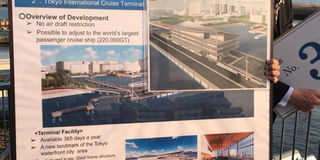IAAF World Relays Notebook - Day 3

Officials display an architectural design of the upcoming Tokyo International Cruise Ship Terminal. The largest ocean liner in the world is expected to make her maiden anchor at the new terminal on July 21, 2020, three days ahead of the start of the Tokyo Olympic Games. PHOTO | ELIAS MAKORI |
What you need to know:
- The Japanese always strive to complete projects well ahead of designated schedules.
Keep time, or lose a good friend
*****
The easiest way to part ways with the Japanese is to fail in time-keeping. It’s an integral part of the impeccable Japanese social, ethical and moral fabric to always be punctual and observe flawless time-keeping.
Being late for even one minute will make a Japanese national hate you, Kenya’s deputy head of mission in Tokyo, Paul Kaliih, explains. “To avoid this, they always make sure they are at the venue of appointment five to 10 minutes ahead of time to wait for the
appointment time, and, on the dot, they knock on your door,” Kaliih notes.
“They will allow you five minutes, if you are not ready, they walk away. They wont mind abandoning the appointment even if it’s a deal worth millions!” On the contrary, in most of our African societies, it’s almost a miracle when one arrives for a meeting ahead of time!
Japanese project always ahead of time
*****
Still on time-keeping, the Japanese always strive to complete projects well ahead of designated schedules. Their most precious resource is time. For instance, when they undertook the new Mombasa port terminus project and started construction in 2013, they promised to complete the works by February, 2016. But they were done with the construction by January 1, 2016, a month ahead of schedule.
In August, at the Seventh Tokyo International Conference on African Development (TICAD VII), Kenya and Japan are expected to sign an agreement on the construction of the new Likoni Bridge. The Japanese already have the date when the work will be complete, and they won’t make any errors because, after all, time is the most precious resource in Japanese culture.
Date set for largest ship to dock
*****
One of the biggest, latest development’s in Tokyo’s impeccable infrastructure is the construction of a berth for the world’s largest ship. The Tokyo International Cruise Terminal will be the latest landmark in the Tokyo waterfront sea area and will be able to accommodate the 345-metre long RMS Queen Mary 2, the world’s largest trans-Atlantic Ocean liner, which is expected to make its maiden dock on July 21, 2020, just three days ahead of the Tokyo Olympic Games’ opening ceremony.
Most European and Asian sports enthusiasts will travel by sea to watch the Tokyo Olympics, hence the spirited focus to enhance the Japanese
capital’s port offerings.
Sports transforming Japan’s infrastructure
*****
Despite often being frowned upon by rudderless technocrats, sports is a huge catalyst for socio-economic development. As advanced as they already are, the Japanese are clinging onto sport to catapult Tokyo’s infrastructural transformation. Next year’s Olympic Games in Tokyo will welcome the construction of new roads, railway systems, ports, residential and office buildings along with stadiums.
Japanese engineers are reclaiming land from the Pacific Ocean to create new roads, bridges and two dams that will be used for the canoe rowing competition.
The new roads and bridges will also help ease traffic congestion with the new stadiums under constructions being fitted with anti-earthquake devices using
high-tech, cutting edge Japanese technology. Earthquakes are a common phenomenon here.





